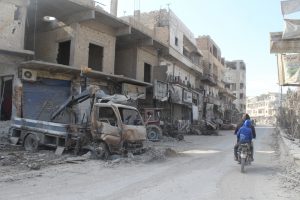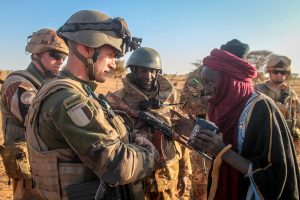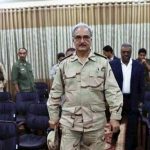by Wayne White
Mali finally signed a ceasefire with Tuareg separatists negotiated by the UN and the EU, potentially opening the way for the return of a central government presence to the key Saharan provincial capital of Kidal. Mali also recently secured a major Western aid package. Yet, tensions between the government along with its southern Malian base and the northern Tuaregs remain high. Meanwhile, with foreign troops inside Mali, Islamic extremist groups with ties to al-Qaeda have shifted their base of operations to southern Libya, have become more difficult to track, and lately have been raiding Mali’s vulnerable eastern neighbor, Niger.
Late last year, militants of the MUJWA (Movement for Unity and Jihad in West Africa) capitalized on a Tuareg separatist rebellion in northern Mali to thrust south in an attempt to seize the entire country, advancing nearly to the Malian capital of Bamako. French forces intervened, along with some allied African forces, especially from Chad, to drive them mostly out of Mali, killing hundreds of extremist fighters. That left the Malian Tuareg in peril in their surviving enclave in the north centered on Kidal. The ceasefire with the Tuareg NMLA (National Movement for the Liberation of the Awazad — the Berber Tuareg name for the hazy Saharan region spanning northern Mali, northwestern Niger and southern Algeria) was needed to recover the rest of Mali before the national elections scheduled for July 28.
The humbled NMLA had little choice in the matter. Malian forces had been advancing on Kidal, threatening to attack if no agreement was reached (in which the NMLA agreed to disarm). Deep tensions persist because southern Mali’s African populations remain angry and resentful toward the NMLA for accepting jihadist aid that nearly led to the collapse of the country, and the Tuareg remain fearful of renewed southern repression. An Amnesty International report released last Friday accused the MNLA of abuses (holding southern prisoners, as well as robbing, beating and executing them), but also described Malian security forces’ overall human rights record as “appalling,” which is the reason why French and Chadian forces in Mali have only reluctantly turned militant prisoners over to Malian authorities. They fear more Malian government executions and torture, seen in various areas across the south.
So although a ceasefire has now been worked out with the MNLA, carrying with it the possibility of greater autonomy for the Tuareg north, restoring any real trust will take time. Nonetheless, relations between Tuareg and southerners in Mali must be repaired to the extent that both sides can settle into some sort of working relationship. This means, most importantly, no further Tuareg-Malian government violence or jihadist penetration into the Tuareg north because one inevitably leads to the other.
In dealing with the threat posed by the MUJWA and other jihadist groups — all with links to al-Qaeda — Mali cannot be viewed in isolation. The largely Saharan Sahel region from Mauritania in the west to Chad in the east is much like Mali in terms of north-south tensions between southern capitals and populations tied closely to sub-Saharan Africa on the one hand and less settled Tuareg populations in the north with links to North Africa. So with southwestern Libya having precious little functioning central or even localized tribal militia governance, this trackless void now hosts most all the al-Qaeda linked extremist elements once thriving inside Mali. They now harbor ambitions to consolidate while continuing to lash out at western and unfriendly African targets.
First the notorious Mokhtar Belmokhtar unleashed his al-Qaeda linked break-away Islamist Masked Brigade in retaliation for French victories over jihadist forces in Mali against the Amenas natural gas facility in southeastern Algeria. It was seized along with hundreds of hostages in late January, triggering a major crisis. Then, probably responding to false reports of his death in April, he claimed partial responsibility for simultaneous May 23 MUJWA attacks against an army barracks in Niger’s northern provincial capital of Agadez and the French-owned Somair uranium mines at Arlit, deeper in the desert northeast of Agadez, killing 25. French forces had to intervene to wipe out the last of the Agadez barracks attackers. Also in May, apparently because Chad played the leading African role in Mali against the jihadists, a probable MUJWA attack on Chad’s consulate in the southern Libyan city of Sabha left one dead.
Belmokhtar and other extremist leaders have learned some survival skills from their defeat in Mali. French and Western forces using aerial surveillance to locate militant convoys for targeting have now observed that jihadis no longer travel in large convoys, but rather in single or only several vehicles difficult to distinguish from private and commercial vehicles (that frequently have to travel “off-road” because of the paucity of infrastructure). Also, MUJWA and other extremist groups have recruited large numbers of disaffected sub-Saharan Africans who can infiltrate countries like Niger better than their Algerian, Tuareg and other northern cadres. Despite French, US and British reconnaissance aircraft and drones participating in widespread monitoring of this huge region, a US official recently admitted: “At any given time, they could be anywhere.”
Another problem has been weak regional cooperation. Niger and more distant Chad are doing just about everything they can to help. But Algeria, from which much of this Islamic extremism originally emanated in the late 1990’s as Algerian rebel militants retreated farther into the desert, resents French involvement in the region. Algiers gave only minimal assistance to the campaign in Mali. And Mauritania flanking Mali to the West downgraded ties with Mali in 2010 over the Malian release of a Mauritanian al-Qaeda detainee in a hostage situation. Such local drawbacks caused French President Francois Hollande to concede in late May that, albeit reluctantly, French forces may have to be used elsewhere in the Sahel well beyond Mali.
Mali remains a work in progress with a dicey national election fast approaching to hopefully advance its transition back to a more democratic system lost in a 2012 coup. And clearly a lot remains to be done to achieve a final compromise with the MNLA in the north to suppress further bloodshed. These needs prompted last month’s generous $4.3 million Western aid package to help get Mali back on its feet. Meanwhile, still formidable extremist leaders and combatants regrouping in lawless southwestern Libya promise more regional violence and will remain a daunting challenge to counter-terrorism and anti-insurgency efforts elsewhere in this vast, arid, impoverished region.





